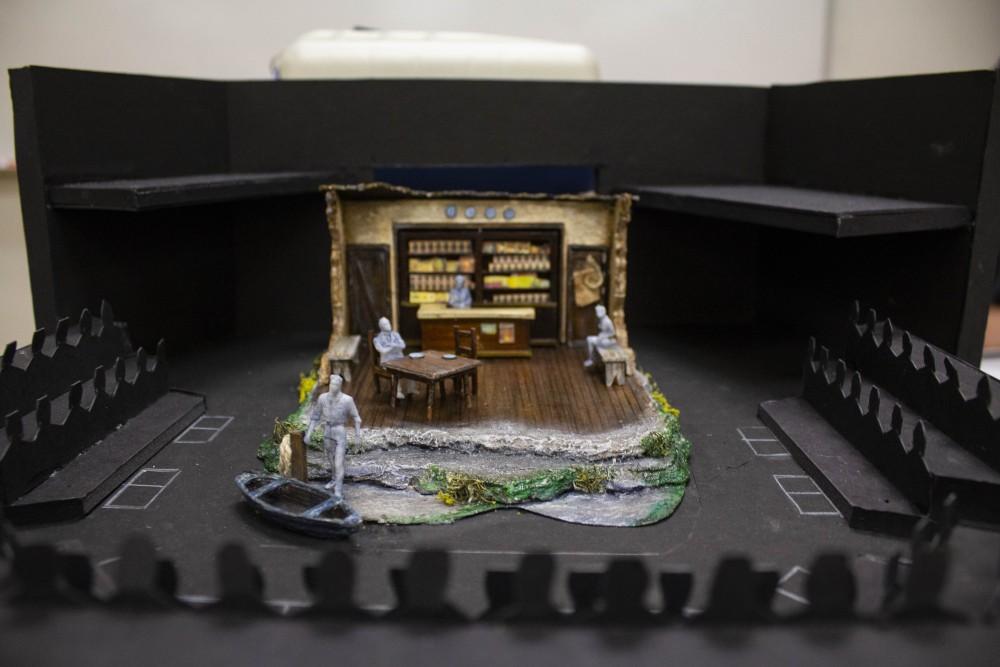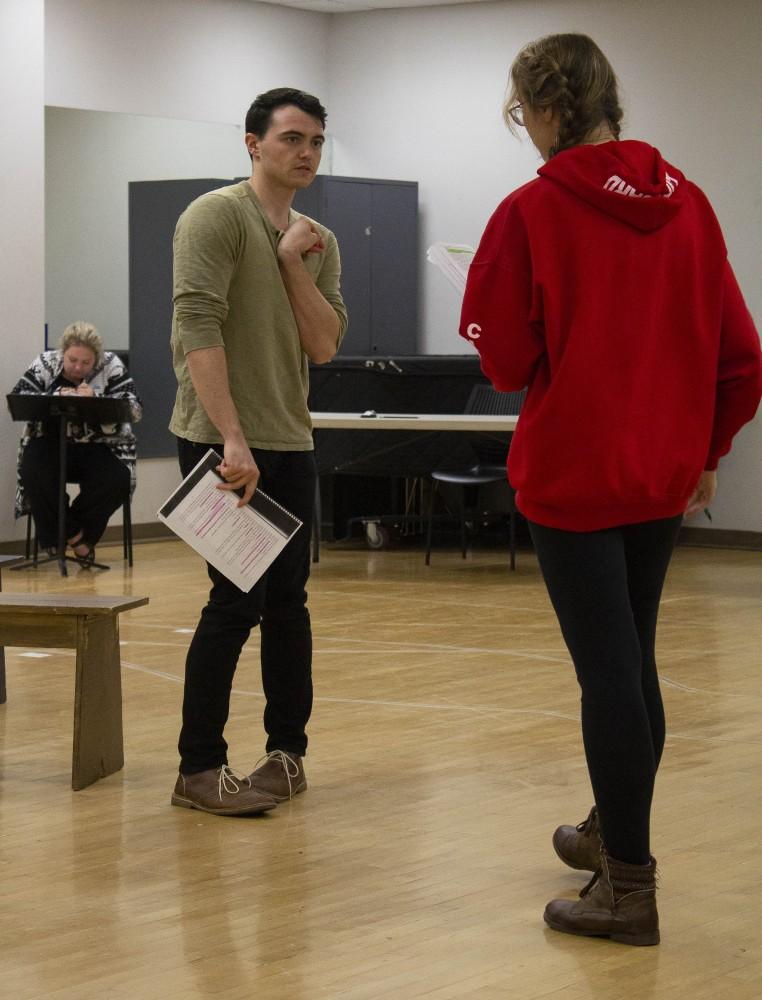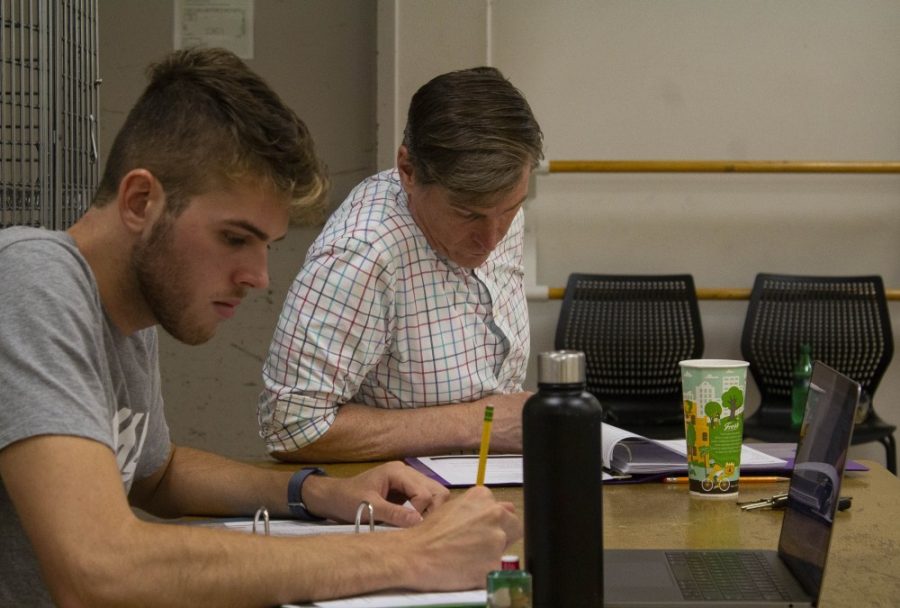The fact that there’s no real stage or audience has zero effect on the echoing voices of the University of Arizona student actors as they rehearse for The Cripple of Inishmaan in room 114 of the Drama Addition.
All the emotion and all the grit and power within each character is there and ever present. The room feels as heavy with tension as it would on the stage during a live audience performance.
The mannerisms in each character show through. Dylan Cotter, playing Billy Calven, portrays Billy’s disability constantly. His left hand contorts into his chest while his left foot shuffles behind his right. The defining traits of the main character are continuous and practiced from the beginning to the end of rehearsals.
RELATED: Behind the curtain: a look at UA student theater’s fall and spring lineups
Elena Richardson’s character, Eileen, has a somewhat brutish nature to her. While Richardson herself is not brutish at all, she plays Eileen well, remembering to keep her heels firmly planted on the floor to better portray her character.
She, along with the rest of the cast, has to focus not only on the physical aspect of playing her character but also on her lines and the way they flow in a heavy Irish accent.
The dialect coach, Kevin Black, has been working with the students in preparation for the play. The Irish accents come through in their voices and never falter throughout the entirety of their practice. Black has worked with Irish accents in the past and said that there’s no single standard when it comes to this specific accent.

“There’s probably as many accents in Ireland as there are actual people in Ireland,” Black said. “It’s very hard to find a standard, and that’s the funny balancing act we have to do. I definitely want the cast to sound like they’re authentic, but also keep to their unique character.”
Black said that his main goal in terms of the Irish accents is to make it clear that all of the characters seem like they’re “from the same island, and that their manner of speaking is shared and common to everybody.”
RELATED: Musical production molds young actors
Black also mentioned that while this is the goal that the cast is working towards, he still wants everybody to have a sense of individuality, hence the balancing act of having a confluence but also a uniqueness.
“It’s very easy for me to think of it purely as the sounds you’re making and then reshaping in order to make it sound like you are from Ireland, but it’s really much deeper than that,” Black said. “It has to do with: ‘Who is this person, how is this person dealing with other people and what are the vocal actions they take in order to accomplish what they want?’”
Aside from practicing mannerisms and accents, the actors are memorizing both their lines and the staging for the play.
Hank Stratton, the director of the production, has a very specific creative process when it comes to flushing out the details in a scene. There is a go-stop-go nature to the directing that perfects every detail before moving on.
Stratton tries one scenario, decides it can be improved, goes back to the beginning with a different scenario and tries again over and over until the scene is as he sees it in his mind’s eye.
“What we try to do is to get a rough shape and then adjust it from there,” Stratton said.
He mentioned the collaboration he has with his student actors and the tools they have that are not in his toolbox. Stratton said he feels that this is what really makes the play flow and work from one scene to the next.
That and the actual physical scene of course. Right now the students aren’t practicing on stage, but in a room.

The room itself is as much a factor as the chairs and tables when it comes to blocking. The floor of the room is taped to mimic what will be on stage. There is a space for everything: the doors, the walls, the steps from the lower to the higher stage with numbered markings and anything else that the actors will encounter when it comes time for the performance.
“That’s to scale,” Stratton said. “Those inches that you’re seeing are elevations. It’s there to give an actor a sense of awareness.”
A specific part of the set that stands out is the very bottom, where there are three different elevations leading to the main stage. There is the ground level, zero inches, and two more steps, one at eight inches and the other at 16, that lead to the top.
“Joe’s idea, which is something we collaborated on, is that that’s the eroding shore line of the island going into the sea, which makes the shop itself is an isolated piece for the island. It’s representative,” Stratton said. “Adding to the isolation that Billy feels, adding to the isolation that all of the characters feel. The audience will walk it, get their ticket ripped off and step into the world.”
Follow Sofia Moraga on Twitter









